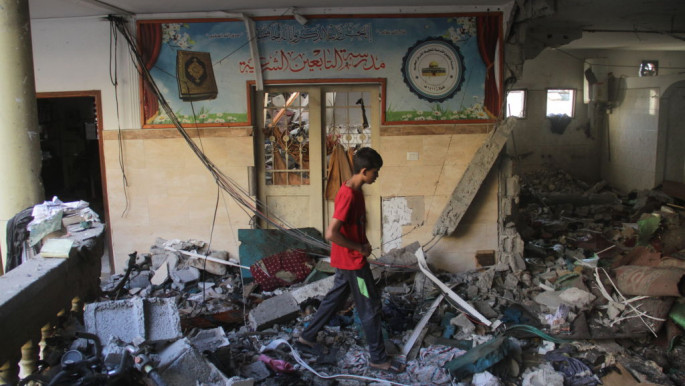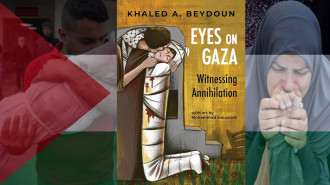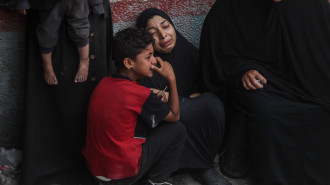
The year that witnessed Gaza's cultural devastation due to Israel's war

Since October 7, 2023, Gaza has endured ongoing attacks by Israel that have claimed thousands of Palestinian lives, displaced many more, and left countless people injured and hungry.
Israel's assaults have also targeted Palestinian cultural sites, revealing a deeper form of erasure often overshadowed by the immediate human toll of the conflict.
This cultural erasure, however, did not begin on October 7.
For years, Israel has aimed to sever Palestinians from their history and identity as part of its settler-colonial strategy to erase all signs of Palestinian presence from collective memory, and one of the ways it has achieved this is through cultural plundering.
Since the start of Israel's war, over 200 heritage sites have been severely damaged or completely destroyed, and in the days following October 7, all civilian infrastructure — including cultural and historical sites — has become battlegrounds in the Gaza conflict.
One year on, The New Arab presents a timeline of some of the cultural sites destroyed by Israel.
October 2023
The first major loss occurred on October 8, when the al-Amin Muhammad Mosque in Khan Yunis was obliterated by an airstrike.
This mosque, a place of worship and community gathering, represented the rich Islamic heritage of Gaza, which is home to a majority Muslim population.
Its destruction signalled the start of a targeted campaign that would, in the months to come, devastate numerous cultural and religious landmarks.
Among the earliest casualties was the Rashad Shawa Cultural Center, a hub for intellectual and cultural activities that housed a library and hosted various events over the years.
At the time of its destruction, the centre also served as a refuge for displaced civilians, reflecting the fate of many other institutions in Gaza.
By the end of October, the Omari Mosque and Library, a site of immense historical and religious significance, was bombed.
Built in the 7th century, the mosque contained one of the most important collections of rare books in Palestine, including works dating back to the 14th century.
Israel’s destruction of the mosque left it in ruins; fortunately, over 200 manuscripts from the library had been digitised before the destruction.
Researchers who funded the digitisation noted that the mosque had already faced threats of destruction from Israel.
November 2023
By November 2023, libraries — often seen as repositories of collective memory — became targets.
The Central Archives of Gaza City, which contained 150 years of historical records, was destroyed by shelling in early November.
This loss was irreplaceable, as documents detailing Gaza’s history, including Ottoman and British Mandate-era materials, were lost forever.
In a report by the Librarians and Archivists with Palestine, the organisation assessed the widespread destruction of Gaza's cultural heritage sites from October 7 to early January, highlighting a consistent pattern of Palestinian cultural erasure that dates back to the Nakba in 1948, when approximately 30,000 books and manuscripts were looted from Palestinian homes.
The report also noted a similar pattern of looting following the 1982 invasion of Lebanon, when Israel confiscated the library and archives of the Palestine Liberation Organisation.
Continuing this legacy, the destruction of the Al-Qarara Cultural Museum, which held artifacts from over 6,000 years, and the Rafah Museum, which housed hundreds of heritage items, followed shortly after.
Additionally, the Akkad Museum, which contained artifacts from Gaza’s rich archaeological history, was also partially damaged during this period.
By mid-November, Israel intensified its assault on Gaza’s schools, leading to the destruction of over 80 per cent of the region’s educational facilities.
Among the hardest hit was the Islamic University of Gaza, which suffered significant damage, especially to its library.
This university had been a cornerstone of Gaza’s academic community, offering vital programs in science, humanities, and social studies that shaped the region's intellectual foundation and future.
Despite claims from propagandists that the university served as a Hamas hub for weapon manufacturing, these justifications for strikes were flawed and unsubstantiated.
At this point in the war, Israel’s brutal destruction of Palestinian culture and history marked a new chapter in a long history of devastation in Gaza.
Almost all of the region’s universities faced complete demolition or severe damage, resulting in the death and displacement of countless faculty, students, and staff.
This damage not only further crippled Gaza’s educational system but also worsened the ongoing erosion of its academic future.
December 2023
By December 2023, Israel had destroyed more than 100 heritage sites in Gaza, including the ancient Port of Anthedon, a UNESCO-recognised archaeological site dating back to 800 BC and the first known seaport of Gaza.
Once a bustling trade hub linking the civilisations of the Mediterranean and the Middle East, Anthedon represented a significant loss for Palestinians and global heritage alike.
Religious sites were also not spared from the devastation.
The Monastery of Saint Hilarion/Tell Umm Amer, another site of immense cultural and historical significance, faced critical threats by the end of 2023.
This ancient monastery was recognised as a "World Heritage in Danger" by UNESCO, and in response to the ongoing conflict, UNESCO’s Intergovernmental Committee for the Protection of Cultural Property in Armed Conflict granted it 'provisional enhanced protection' under the 1954 Hague Convention, emphasising the importance of preserving such endangered heritage.
Adding to the losses, the 15th-century Ibn Uthman Mosque, known as the “second great mosque of Gaza,” was reduced to rubble by an airstrike in Gaza’s historic Shuja’iyya neighbourhood.
This mosque had survived centuries of change, from the Mamluk era to Ottoman rule, serving as a testament to Gaza's lasting spiritual and architectural heritage. However, by the end of the month, the Omari Mosque was struck again, this time almost entirely destroyed, with only its minaret left standing in ruins.
January 2024
By January 2024, assessments revealed the staggering scale of Israel's cultural destruction.
Over 300 architectural heritage sites have been damaged or destroyed, and more than half of Gaza’s buildings are in ruins, leaving over 1.7 million people displaced.
In this context, the World Bank estimated the cost of damage to critical infrastructure alone between October 2023 and January 2024 to be around $18.5 billion.
Highlighting the devastating impact on cultural resources, the aforementioned report by Librarians and Archivists with Palestine detailed extensive damage to university libraries, noting a disturbing pattern of theft and looting that occurred prior to their destruction.
Among the affected institutions are the Islamic University of Gaza Library, the Al-Israa University Library, and the National Museum.
Summer 2024
The summer of 2024 was especially brutal for Gaza, marked not only by relentless airstrikes but also by devastating heat waves and worsening famine conditions.
With scarce access to food, water, and electricity, the already dire humanitarian situation intensified, pushing Gaza’s population to the brink of survival amid escalating violence.
During this period in the war, the world witnessed the targeting of Saint Porphyrius Church, the third-oldest church in the world and Gaza’s oldest Christian site, built in the 5th century and named after Saint Porphyrius.
This church was targeted twice over the summer months of 2024 and for the third time since October 2023.
The initial bombing occurred while the church was sheltering hundreds of Palestinians, resulting in the deaths of at least 18 civilians, including a three-month-old infant.
Despite its long history, the church continued to be targeted, highlighting a broader pattern of attacks on religious institutions.
Then, on August 10, an Israeli airstrike targeted the Al Tabi'een School in Gaza City, leaving nearly 100 dead and many injured.
The school was being used as a shelter for thousands of displaced people, and, as with much of the data regarding this conflict’s death toll, children made up a significant portion of the casualties.
At this stage of the war, the systematic destruction expanded to cemeteries, with bulldozers leveling sacred burial sites and digging up bodies.
An investigation by CNN, using satellite imagery, revealed that at least 16 cemeteries had been damaged. Among the most significant was the Roman cemetery of Ard-al-Moharbeen, discovered less than a year earlier.
In January, the cemetery had not yet undergone a full assessment, but reports suggested that white phosphorus had been dropped there during the bombings, further damaging this important archaeological site.
September 2024
By September 2024, the international community had failed to intervene, and Gaza’s cultural landscape lay in ruins.
Over 100 heritage sites had been destroyed, and hundreds of additional sites had been looted, damaged, or obliterated, including Gaza’s cultural institutions, schools, and religious sites.
The destruction of cultural sites continues to this day.
The deliberate targeting of heritage sites, schools, and religious institutions is not only an attack on infrastructure but also on the very fabric of Palestinian identity.
Ultimately, this erasure seeks not only to strip Palestinians of their historical narratives and cultural markers but also to perpetuate the discourse of delegitimisation regarding heritage and land power.
Hind Berji is a freelance writer with experience in art reviews and sociopolitical criticism.
Follow her on X: @HindBerji







 Follow the Middle East's top stories in English at The New Arab on Google News
Follow the Middle East's top stories in English at The New Arab on Google News


